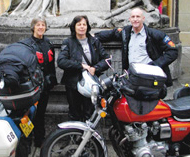
Lost and found in France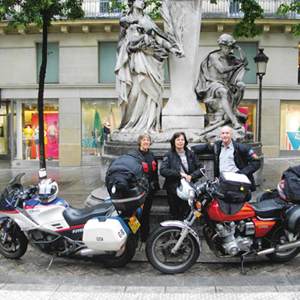
Previously we brought you Ned’s Isle of Man TT Race adventures. This time he learns a lesson in France
Words: Ned Shaw
In the 10th century the Saracens conquered Spain and pushed as far north as the southern slopes of the French Pyrenees, where a fortification was built to halt their progress. This fortification became known as Castelsarrasin, or the Saracen Castle.
The countryside in this area is sublime, deeply fertile, well watered and rich with food and wine. On a sunny afternoon in early summer, there are few better places to tour on a motorcycle. But, as the Saracens found, we were to get thus far and no further.
But back to the beginning.
Two days after landing in the Old Dart I went to collect the mount that would accompany Grant’s ageing Suzuki GS1000G, bought on eBay for $1500. Mine was a 1984 Yamaha FJ1100. I’ve never been keen on buying a bike without first riding it, much less seeing it, but the old FJ had travelling luggage and, at $1100, I figured there was not a lot at stake.
I picked up the FJ from just outside Stoke-on-Trent, which Prince Phillip once happily described as “ghastly”. If that was a bit harsh, the cold ride down the motorway back to London was closer, although finding the way back to the East End was, if nothing else, amusing — assuming being eternally lost and under direct threat of being run over has entertainment value.
No self-respecting motorcyclist could come to London without a quick visit to the Ace Cafe out past the West End. The Friday-night fun, including some feet-up donuts, almost matched the skill and daring required to find the place and then to get back to the hotel again. Using the bus lanes is legal for motorcycles in the UK but it’s not legal in France. So much for EU consistency, eh.
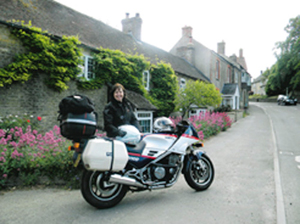
Having sampled this peak of English culture, Ravishing Rae and I scooted down west to Somerset to visit the family village. It’s odd how we trace one name out of four grandparents to great-grandparents and so on. My paternal family left England more than 160 years ago, so the association is slim. This was just like our chances of finding a village that appears to be unconnected other than by semi-paved cow tracks to any other part of the world. I can understand why great-great-great-grandad left: bugger of a place to find and not much there when you do.
The English road system consists primarily of poorly marked roundabouts so, having spent half a day within a 15-kilometre radius, we headed north riding in increasingly larger circles and finally admitting defeat in Bristol. A full day of riding produced a hefty 130 kilometres as the crow flies.
From Bristol it was across the eastern midlands to the Donnington circuit. That might have been an OK ride except that it bucketed rain amidst sideways wind squalls from the moment we started, the English motorway traffic ducking and weaving at high speed, having a pathological dislike of using indicators and adding showers of filthy road spray to the already severely limited visibility.
The consequent shattered nerves were considerably calmed, the following day, by a visit to the new Norton factory and a ride on the new Norton cafe racer. The new Norton is a lovely, grunty, precise-handling and, to my eyes, good-looking bike. My smile dimmed only slightly when I got back onto the big, fat old Yamaha. I’d not been able to find chain lube at any of the service stations so the Norton guys gave me a can. The chain was looking very second-hand and this generosity was appreciated.
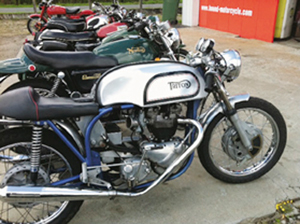
The Sheriff was not in at Nottingham, nor was “Robbing Hood” in Sherwood Forest, so from Donnington we went on up to Whitby, the coastal home of Captain James Cook. Whitby is also where Ravishing Rae’s paternal great-great-grandfather left for India and then Burma around the same time that my forebears were heading for Australia. Ravishing’s father was a product of this colonial lineage, being half Burmese. When asked, however, he would reply he was “British”.
The rain stopped for the run from Darlington across the Yorkshire Dales along winding country roads, through quaint stone villages and past ancient castles in glorious sunshine. In a few short hours we were across the north of England — it really isn’t very wide at the top — and settled in to a B&B in the picturesque Lake District, watching immigrant Canadian geese and English holiday makers all happily honking and quacking while UK fighter planes did daily low-flying practice runs up Lake Windermere.
It’s interesting how many English place names such as Lake Windermere sound familiar; one has to wonder at the lack of English originality with so many names seemingly borrowed from long-established Australian places.
From the Lake District it was a short hop down to the Isle of Man. A week later, sated with the spirit of motorcycle competition (as reported in the last issue), we rolled off the ferry at Heysham into what would be more torrential rain and thrashing wind for a fast cross-country ride to Dover. Even the Pommy motorcyclists we met along the way hadn’t expected the appalling weather and I began to develop a new respect for the (fool)hardiness of English motorcyclists.
In the appalling circumstances, I thought it best to stay in a hotel and perhaps check out the options for crossing to France in the morning. The funny thing is, though, that when you go down to check out the hotels near the channel tunnel entrance, of which there aren’t any, one is automatically fed into the “chunnel” system, from which there is no return and no escape.
There we were, at the gates, without a ticket and no way to go back. One angry operator, an expensive ticket and an hour later and we were rolling, somewhat surprised, into Calais which, as the English unkindly say, is where the non-English people start.
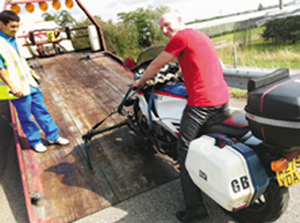
Riding in circles in France!
Needless to say, it bucketed from Calais to Paris and the French drivers were of even less kind intent than the murderous English. Tired, wet and cold, we rolled into the outskirts of Paris, only to spend three hours completely lost and riding in circles, the FJ’s engine emitting an alarming amount of heat and, at lights, a worrying amount of smoke. The thing about air-cooled engines is that they need air to be cool and stopping every 20 metres in peak-hour traffic there was precious little of it.
By this stage I was also getting very good at riding in circles, having completed at least seven laps alone of the Place de Revolution. Its six or seven lanes of madly swerving traffic is now deeply etched into my shattered psyche. And then it started to rain again.
Paris is a fabulous — and fabulously expensive — city but it is no friend to motorcyclists, except perhaps on its motorcycle street, Avenue de la Grande Armée, just near the Arc de Triomphe. But even here the main shop is called Rue de Scooter. I tried to persuade the old FJ that it was a French-speaking scooter and it did pick up a bit of Parisian body language, which makes Australian “lane filtering” look polite. But, in all, it objected to crawling around, stop-start, at 20km/h.
But, late one night on the Boulevard Saint Michel, someone objected to a big, fat motorbike taking a scooter parking spot and pushed it over. The consequent dent and loss of paint on the tank only added to the bike’s obvious age and growing sadness.
Leaving Paris was only slightly less horrible than arriving. We’d hooked up with Grant and Julia from the IoM and decided to leave together. After running down to fumes and then refuelling, Grant said we should follow him. We didn’t and managed to get out of Paris more or less in one piece. Grant did the circles this time and ended up back in central Paris from where we’d begun. Last I heard he’d escaped, made slow time and scrapped all his existing travel plans.
We also got lost again, in the rain, but by luck ended up in the Loire Valley, which is about as good a mistake as one can make. The valley itself is a glade: the well-sealed B-roads curving, the chateaux and castles as if from a fairy tale and the villages and their little rivers and lily-pad ponds seemingly lifted from Monet’s palette.
The countryside around B-roads south was further taken from the impressionists’ easels and it seemed we could not go more than a kilometre or two before going through yet another little village dripping with history. Quaintness aside, 40km/h speed limits did not make for quick travel and our own travel plans were now undergoing on-road modification. At Bordeaux we headed east through the world’s best vineyards where juice of the grape is turned into nectar of the gods.
Instead of north-western Spain, we decided to head north of the Pyrenees towards Barcelona. The countryside changed a little but the charm remained the same. In order to get to Toulouse before dark, we were pushing along the autoroute.
Thwarted like the Saracens
The old FJ had obviously had a hard if relatively low-mileage life and could have done with considerable TLC. I had pumped up the tyres, put oil in the engine and lubed and adjusted the chain. The chain had seen better days but I was being kind to it, or so I thought.
The sun was just starting to descend towards the mountaintops in the region of Castelsarrasin where the Moorish onslaught north was thwarted. We were motoring at about 130km/h or so and, for the first time, passing much more traffic than was passing us.
The sound of something mechanical letting go on a motorcycle at speed is disturbing and, assuming one is not on one’s arse sliding along the road, good for one’s sense of focus; clutch immediately in, pucker up and move across to the emergency lane and slow gently, but definitely, and hope that something doesn’t lock up.
The pool of oil looked like the bike had thrown a con rod but the broken chain hanging out of a hole in the gearbox, a big crack in the cases and a gear level that would no longer budge indicated the culprit. I found a highway telephone and called for assistance.
My fabulously limited French came to the fore. “J’ai un problem avec mon moto,” I said into the steel box. “C’est mort.” It was indeed mort, from which derives the word mortality and, perhaps more appropriately, murder.
If not murder, it was at least culpable homicide (or bikicide). I blame the previous owner for what had clearly been a lack of maintenance for many years. Just about everything that could need doing to the old FJ did. Adjusting and lubing the chain was merciful by comparison. But, in the end, proper tensioning along with years of abuse combined to destroy the engine cases.
So, now Ravishing I were sitting in a train station, happy we didn’t end up sliding down the road with a locked rear wheel in a gush of oil but receiving somewhat colder comfort from the thought that French trains are clean, quick, warm and dry. And all this just as we were greeting the first fully sunny and warm day since starting riding a month ago.
I suppose as European motorcycle touring goes our experiment with the old FJ was probably not, all in all, a fabulous success. But we ended up having a month of riding in the UK and France at considerably less money per day than we have since discovered it costs to rent a scooter in Spain.
Would we do it again? Absolutely! Did we learn any lessons? Possibly spend a bit more and buy a bike you can look at and ride before committing to it. Now for some motorcycling in the US! Ancient FJs need not apply.
